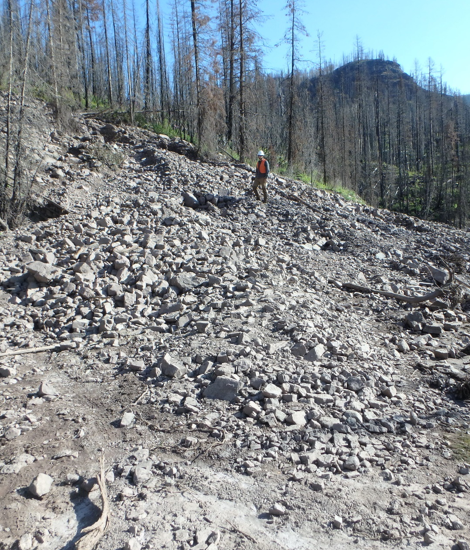 Over the past several decades, the occurrence of large fires has increased in many western US forests. Associated with the rise in fire activity is the incidence of post-fire debris flows and their effects on watershed resources and associated communities. Post-fire debris flows can be defined as fast moving, gravity-driven landslides containing mud, sand, soil, rock, water, and air and traveling downslope on recently burned landscapes. The resources listed here address factors that influence the occurrence and severity of debris flows, potential consequences of post-fire debris flows, debris flow assessment, and mitigation efforts such as pre-fire fuel treatment and post-fire soil, slope, and channel stabilization.
Over the past several decades, the occurrence of large fires has increased in many western US forests. Associated with the rise in fire activity is the incidence of post-fire debris flows and their effects on watershed resources and associated communities. Post-fire debris flows can be defined as fast moving, gravity-driven landslides containing mud, sand, soil, rock, water, and air and traveling downslope on recently burned landscapes. The resources listed here address factors that influence the occurrence and severity of debris flows, potential consequences of post-fire debris flows, debris flow assessment, and mitigation efforts such as pre-fire fuel treatment and post-fire soil, slope, and channel stabilization.
This hot topic was developed in partnership with Montana State University and Rocky Mountain Research Station.
Recorded Webinars
Conference Proceedings
- Looking through the window of disturbance at post-wildfire debris-flow hazards
- Taking the pulse of debris flows: Extracting debris-flow dynamics from good vibrations in southern California and central Colorado
- Wildfire impacts on stream sedimentation: re-visiting the Boulder Creek Burn in Little Granite Creek, Wyoming, USA
- Probabilistic soil erosion modeling using the Erosion Risk Management Tool (ERMiT) after wildfires
- Getting results: measuring post-wildfire erosion control treatment effectiveness
- Runoff and erosion effects after prescribed fire and wildfire on volcanic ash-cap soils
- The potential influence of stair-step morphology on the initiation of bulking debris flows in southwestern Idaho, USA
- Impacts of fire and mass wasting on channel morphology and stream temperature in mountain rivers of central Idaho (abstract)
- Wildfire and erosion: when to expect the unexpected
- Comparing erosion risks from forest operations to wildfire
- Channel characteristics and large organic debris in adjacent burned and unburned watersheds a decade after wildfire
- Fire-induced water repellency: an erosional factor in wildland environments
- Spatially-varied erosion modeling using WEPP for timber harvested and burned hillslopes
- Sediment routing by debris flow
- Plant nutrients and soil losses in overland flow from burned forest clearcuts
Technical Reports/White Papers
- Effects of time since burn, spatial scale and post-fire treatments on rainfall thresholds to produce runoff and erosion from plot to watershed-scale
- Climate change impacts in the United States: The third National Climate Assessment
- Probability and volume of potential postwildfire debris flows in the 2012 High Park Burn Area near Fort Collins, Colorado
- Three years of hillslope sediment yields following the Valley Complex fires, western Montana
- Erosion Risk Management Tool (ERMiT) user manual
- Compilation of data relating to the erosive response of 606 recently burned basins in the western U.S.
- Hayman Fire case study: summary
- Fire-related debris flows in the Beaver Creek drainage, Lewis and Clark County, Montana